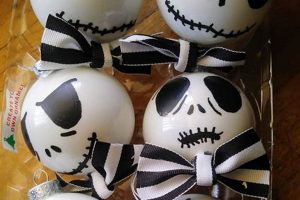Handcrafted adornments, fashioned from pliable sheets during the yuletide season, serve as individualized festive enhancements. Examples include intricate snowflakes, three-dimensional stars, and customized garlands created using folding, cutting, and gluing techniques. These items offer a personalized alternative to commercially produced holiday decor.
The creation of bespoke seasonal embellishments presents several advantages. It allows for cost-effective decoration, promotes creative expression, and provides an engaging activity suitable for individuals and groups. Historically, the practice reflects a tradition of resourcefulness and personalized celebration predating mass-produced goods.
The subsequent sections will explore specific projects, material considerations, and techniques for achieving aesthetically pleasing and durable results within the realm of self-made holiday ornamentation. These projects offer a tangible outlet for festive creativity.
Crafting Exquisite Holiday Ornaments
Achieving professional-looking, durable, and aesthetically pleasing paper-based holiday ornaments requires careful planning and execution. The following guidelines offer insight into best practices.
Tip 1: Material Selection: Opt for cardstock or heavier-weight paper to provide structural integrity. Thinner paper is prone to tearing and may lack the necessary rigidity for three-dimensional designs. Consider acid-free paper for archival quality.
Tip 2: Precision Cutting: Utilize a craft knife or sharp scissors for intricate designs. Employing a cutting mat will protect work surfaces. Precise cuts are crucial for achieving clean lines and a polished final product.
Tip 3: Adhesive Choice: Select appropriate adhesives based on paper weight and design complexity. Glue sticks are suitable for general assembly. Liquid glue provides a stronger bond but requires careful application to prevent warping. Double-sided tape offers a clean, instant hold for layering.
Tip 4: Folding Techniques: Master basic origami folds for creating intricate three-dimensional shapes. Practice folding techniques on scrap paper before committing to final materials. Sharp, precise folds are essential for achieving desired forms.
Tip 5: Reinforcement Strategies: Reinforce delicate areas with clear tape or additional layers of paper to enhance durability. For hanging ornaments, use sturdy string or wire and ensure secure attachment points.
Tip 6: Sealing and Protection: Applying a thin layer of clear sealant or varnish can protect the paper from moisture and enhance its longevity. Allow the sealant to dry completely before handling or displaying the finished ornaments.
Tip 7: Consider Color Theory: Strategically select colors that harmonize with the existing holiday decor. Consider using a limited color palette for a cohesive and sophisticated look.
Adhering to these guidelines promotes the creation of high-quality, long-lasting, and visually appealing holiday decorations. Consistent attention to detail throughout the crafting process yields professional results.
The subsequent section will offer project ideas and templates to further inspire creative endeavors in crafting bespoke seasonal adornments.
1. Material Weight
The selection of paper weight directly impacts the structural integrity and visual appeal of self-made seasonal ornaments. A heavier paper stock, such as cardstock, offers enhanced durability, allowing the creation of ornaments that withstand handling and maintain their form over extended periods. Conversely, lighter-weight paper, while easier to manipulate, may result in decorations that are flimsy and prone to damage. The choice, therefore, hinges on a balance between ease of crafting and desired longevity. The use of lightweight crepe paper for delicate paper flowers exemplifies an appropriate application of thin material, while a multi-layered cardstock star benefits from a heavier weight.
The aesthetic qualities are also inextricably linked to material weight. Heavier paper tends to hold creases more sharply, leading to defined shapes in geometric designs and origami figures. This crispness contributes to a polished, professional appearance. Conversely, thinner paper can result in rounded edges and a less defined form, suitable for projects prioritizing a softer, more whimsical aesthetic. Consider the effect of varying material weights on different ornament designs: a robust paper lantern built with cardstock will maintain its shape far better than one constructed from printer paper. Likewise, delicate paper snowflakes gain greater detail and definition when cut from mid-weight paper rather than flimsy tissue paper.
Therefore, the intentional selection of material weight is paramount in achieving successful outcomes in paper-based festive decor. The interplay between structural requirements and aesthetic preferences dictates the optimal choice. Recognizing this relationship allows for informed decisions that enhance the final product, aligning it with the desired visual impact and ensuring its durability for repeated seasonal displays. A misjudgment of the paper’s weight will inevitably lead to an unsatisfactory result, emphasizing the importance of informed material selection.
2. Folding Precision
The accuracy of folds executed during the creation of paper-based holiday adornments significantly impacts the final aesthetic and structural integrity. Precise folds are not merely a stylistic choice but a fundamental requirement for achieving professional-looking, durable, and visually appealing seasonal decorations. Without accurate folds, even the most elaborate designs can appear amateurish and structurally unsound.
- Structural Stability
Precise folds contribute directly to the structural stability of three-dimensional ornaments. In designs such as origami stars or geometric spheres, each fold acts as a load-bearing element. Inaccurate folds introduce weak points, compromising the overall strength and potentially leading to collapse. For example, a poorly folded origami crane will lack the necessary tension in its wings, resulting in a drooping and unstable structure. The consistent application of precise folding techniques distributes stress evenly across the ornament, ensuring its long-term stability and resistance to damage.
- Aesthetic Definition
Folding precision is paramount to the visual appeal of paper decorations. Clean, sharp folds create well-defined edges and crisp lines, resulting in a polished and professional appearance. Conversely, imprecise folds introduce rounded edges, uneven surfaces, and a general lack of definition. Consider the difference between a neatly folded paper snowflake with sharp, symmetrical points and one with rounded, asymmetrical edges. The former conveys a sense of quality and craftsmanship, while the latter appears less refined.
- Symmetry and Alignment
Many paper-based holiday decorations rely on symmetry and precise alignment of different components. Accurate folding is essential for achieving the desired symmetry and ensuring that all elements of the design align correctly. For instance, in the creation of a modular origami ornament, each unit must be folded identically to ensure proper interlocking and a cohesive final form. Even minor variations in fold accuracy can disrupt the symmetry and compromise the overall aesthetic. The precise alignment of edges and corners is crucial for maintaining the visual harmony of the ornament.
- Complexity and Detail
Intricate paper decorations with complex patterns require a high degree of folding precision. As the number of folds increases, the margin for error decreases. Each inaccurate fold can compound the errors in subsequent folds, leading to a final product that deviates significantly from the intended design. Projects involving complex tessellations or advanced origami techniques demand meticulous attention to detail and flawless execution of each fold. Successfully completing such projects requires a commitment to precision and a thorough understanding of folding principles.
In conclusion, the act of creating paper-based holiday decorations requires more than simply folding paper. Precise execution significantly influences the durability, aesthetic appeal, and overall quality of the final product. Whether crafting simple paper chains or intricate origami figures, careful attention to folding accuracy is essential for achieving professional-looking and long-lasting seasonal adornments. The commitment to precision elevates the craft from a simple activity to an art form, transforming ordinary paper into extraordinary festive decorations.
3. Adhesive Strength
The selection and application of appropriate adhesives is paramount in the successful creation and longevity of handcrafted festive paper decorations. Adhesive strength, therefore, represents a critical factor influencing the durability, stability, and overall aesthetic of such projects. The integrity of the final product is directly dependent on the adhesive’s capacity to maintain structural cohesion under various environmental conditions and physical stresses.
- Joint Integrity
Adhesive strength directly correlates with the integrity of joints within paper-based decorations. Securely bonded joints prevent separation and ensure that individual components remain united, maintaining the intended form of the ornament. For example, a poorly adhered seam on a paper lantern will compromise its structural integrity, leading to potential collapse. Robust adhesive bonds are crucial in designs involving intricate layering or complex geometric constructions, providing the necessary support to withstand handling and display.
- Material Compatibility
Different paper types require specific adhesive formulations to achieve optimal bonding. Certain adhesives may react adversely with delicate papers, causing discoloration, warping, or even tearing. Selecting an adhesive that is chemically compatible with the chosen paper stock is essential for preserving the aesthetic qualities of the decoration. Acid-free adhesives are generally preferred to prevent long-term degradation of the paper. Furthermore, the adhesive’s viscosity and drying time should be considered to avoid bleeding or wrinkling, which can detract from the overall appearance.
- Environmental Resistance
Finished paper decorations are often exposed to varying environmental conditions, including fluctuations in temperature and humidity. Adhesive strength must be sufficient to withstand these environmental stresses and prevent bond failure. High humidity can weaken certain adhesives, leading to delamination or separation of components. Similarly, extreme temperatures can affect adhesive elasticity, causing bonds to become brittle and prone to cracking. Selecting an adhesive with appropriate environmental resistance is critical for ensuring the long-term durability of outdoor decorations or those displayed in humid environments.
- Application Technique
Even the strongest adhesive will fail if improperly applied. Consistent and even application is essential for maximizing bond strength. Over-application can lead to adhesive bleed-through, creating unsightly stains and potentially weakening the paper. Conversely, under-application may result in insufficient bonding and premature failure. Using appropriate tools, such as fine-tipped applicators or glue sticks, can help ensure precise and controlled adhesive placement. Furthermore, allowing sufficient drying time, as specified by the manufacturer, is crucial for achieving optimal bond strength.
The selection and judicious application of adhesive plays a critical role in determining the success of paper-based festive creations. By carefully considering material compatibility, environmental factors, and application techniques, artisans can ensure their festive pieces remain intact and visually appealing for years to come. A robust and thoughtfully chosen adhesive transforms simple paper into enduring festive embellishments.
4. Design Complexity
The level of intricacy inherent in crafted paper holiday ornaments directly influences project feasibility, material requirements, and the skill set necessary for successful execution. Design complexity, therefore, constitutes a critical determinant in selecting and undertaking these seasonal decorative endeavors.
- Geometric Intricacy
Geometric designs, such as stellated polyhedra or complex tessellations, demand precision and mathematical understanding. These designs often involve numerous folds, cuts, and joins, requiring meticulous attention to detail. Examples include intricate origami stars or three-dimensional snowflakes composed of multiple interconnected modules. The successful creation of these ornaments relies on accurate measurements, precise execution of folding techniques, and a thorough understanding of geometric principles.
- Layered Compositions
Layered designs involve the superposition of multiple paper elements to create depth, texture, and visual interest. These compositions may incorporate intricate cutouts, embossing, or paper quilling techniques. Examples include layered paper Christmas trees or elaborate paper flower arrangements. The complexity arises from the need to carefully align and adhere multiple elements, ensuring a cohesive and visually appealing final product. Skillful manipulation of light and shadow further enhances the impact of layered compositions.
- Miniature Replicas
Creating miniature replicas of real-world objects, such as buildings, vehicles, or characters, presents a unique challenge due to the need to accurately represent intricate details at a reduced scale. These designs often involve complex cutting, folding, and assembly techniques, requiring a high degree of precision and patience. Examples include miniature paper gingerbread houses or detailed paper models of iconic holiday scenes. Successful execution relies on careful planning, accurate scaling, and skillful manipulation of paper to achieve a realistic representation.
- Animated Structures
Incorporating moving parts into paper decorations adds a layer of complexity, requiring an understanding of mechanical principles and careful consideration of structural integrity. Animated structures may involve levers, gears, or other mechanisms to create movement or interactive elements. Examples include paper automata that depict holiday scenes or kinetic paper sculptures with rotating elements. The successful design and construction of these ornaments necessitate precise measurements, careful assembly, and the use of appropriate materials to ensure smooth and reliable operation.
In conclusion, the degree of design complexity significantly affects the undertaking of handcrafted holiday ornaments. From simple paper chains to elaborate geometric sculptures, the chosen design dictates the level of skill, time commitment, and material resources required. Careful consideration of design complexity is essential for selecting projects that align with individual skill levels and available resources, ensuring a rewarding and successful crafting experience. Successful realization depends on the crafter’s commitment and skill, turning the original conceptual blueprint into a memorable piece of festive decor.
5. Hanging Method
The suspension of crafted paper holiday ornaments constitutes a critical consideration, directly impacting both the visual presentation and the longevity of the decoration. The choice of suspension technique transcends mere practicality, becoming an integral element of the design itself.
- Weight Distribution
The method of suspension must effectively distribute the weight of the paper ornament to prevent tearing or distortion. Lightweight ornaments may be adequately supported by a single thread, while heavier or more complex designs require multiple support points. Improper weight distribution can lead to premature failure of the ornament. Examples include distributing the weight by utilizing multiple hanging points and strong materials, such as a sturdy paper star hanging by a strong cord looped through several points or reinforcing a weak connection with tape and a lightweight wire structure for heavier elements.
- Material Compatibility
The suspension material must be compatible with the paper stock used in the ornament’s construction. Abrasive or chemically reactive materials can damage the paper over time. For instance, wire can cut into delicate paper, whereas certain adhesives used to attach hanging loops may cause discoloration. Selecting non-abrasive, pH-neutral materials ensures the preservation of the ornament’s aesthetic qualities. An example of this material compatibility would be using an Acid-free paper along with linen thread to hang lightweight paper flowers for durability or avoiding metal hooks with delicate crepe paper ornaments to prevent tearing.
- Aesthetic Integration
The hanging mechanism should complement, not detract from, the overall aesthetic of the decoration. Invisible suspension techniques, such as clear thread or concealed wire, minimize visual intrusion. Conversely, decorative cords or ribbons can be intentionally incorporated to enhance the ornament’s design. This approach requires careful consideration of color, texture, and scale to achieve a harmonious visual effect. Examples include a Paper snowflakes suspended with clear nylon thread creates a floating effect versus Burlap ribbon used to hang rustic paper ornaments which provides added character.
- Environmental Resilience
For ornaments intended for outdoor display, the suspension method must withstand environmental stressors such as wind, rain, and sunlight. Durable, weather-resistant materials are essential. Secure attachment points prevent dislodgement during inclement weather. Considering these aspects is crucial for maintaining the integrity of the ornament throughout the holiday season. For example, consider using sealed paper ornaments with waterproof thread that are suspended under covered porches to protect them versus laminated paper ornament with UV-resistant thread for more direct sunlight exposure.
The careful selection and implementation of a suitable hanging method constitutes a vital aspect of DIY paper holiday decoration. By considering weight distribution, material compatibility, aesthetic integration, and environmental resilience, craftsmen can ensure their creations are not only visually appealing but also durable and long-lasting. The effective marriage of design and suspension transforms a simple paper creation into a cherished holiday heirloom.
Frequently Asked Questions
The following addresses frequently encountered inquiries regarding the creation and maintenance of handcrafted festive paper adornments. These answers aim to provide clarity and guidance for successful execution.
Question 1: What is the optimal paper weight for creating durable paper Christmas decorations?
Cardstock, typically ranging from 65lb to 110lb, offers the best balance of durability and workability for most designs. Lighter papers are suitable for delicate projects, while heavier stock provides increased structural integrity for larger ornaments.
Question 2: Which adhesives are most effective for bonding paper elements in Christmas ornaments?
Acid-free glue sticks are suitable for general assembly. Liquid glue provides a stronger, permanent bond but requires careful application to prevent warping. Double-sided tape offers a clean and instant hold for layering.
Question 3: How can one prevent paper Christmas decorations from fading or deteriorating over time?
Use acid-free paper to minimize chemical degradation. Store ornaments in a cool, dry place away from direct sunlight. A thin coat of clear sealant can provide additional protection against moisture and UV damage.
Question 4: What techniques can improve the precision of cuts when creating intricate paper designs?
Utilize a sharp craft knife or scissors. Employ a self-healing cutting mat to protect work surfaces. Print templates directly onto the paper or use transfer paper for accurate tracing. Consider using a cutting machine for complex designs.
Question 5: How can one reinforce delicate areas of paper ornaments to prevent tearing or damage?
Reinforce fragile areas with clear tape or additional layers of paper. Consider laminating delicate ornaments for enhanced durability. Distribute weight evenly when hanging to minimize stress on weak points.
Question 6: Are paper Christmas decorations safe for households with small children or pets?
While generally safe, supervise children and pets to prevent ingestion of small parts. Avoid using sharp or pointed elements that could pose a hazard. Opt for non-toxic adhesives and sealants.
Proper material selection, careful construction, and appropriate storage are key factors in creating lasting and enjoyable paper Christmas decorations.
The following section will elaborate on various project ideas to inspire further creative endeavors.
diy paper christmas decorations
This exploration has outlined key considerations for the creation of “diy paper christmas decorations”, emphasizing material selection, adhesive properties, structural integrity, design complexity, and appropriate hanging methods. Adherence to these principles facilitates the crafting of durable, aesthetically pleasing, and enduring festive ornaments.
The careful application of the discussed techniques empowers individuals to produce personalized seasonal adornments that reflect both individual creativity and the enduring spirit of resourcefulness. Further exploration of advanced techniques and innovative designs promises to expand the possibilities within this craft, contributing to uniquely decorated holiday celebrations.







